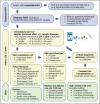New algorithms for treating homozygous familial hypercholesterolemia
- PMID: 36206078
- PMCID: PMC9640271
- DOI: 10.1097/MOL.0000000000000853
New algorithms for treating homozygous familial hypercholesterolemia
Abstract
Purpose of review: We reviewed current and future therapeutic options for patients with homozygous familial hypercholesterolemia (HoFH) and place this evidence in context of an adaptable treatment algorithm.
Recent findings: Lowering LDL-C levels to normal in patients with HoFH is challenging, but a combination of multiple lipid-lowering therapies (LLT) is key. Patients with (near) absence of LDL receptor expression are most severely affected and frequently require regular lipoprotein apheresis on top of combined pharmacologic LLT. Therapies acting independently of the LDL receptor pathway, such as lomitapide and evinacumab, are considered game changers for many patients with HoFH, and may reduce the need for lipoprotein apheresis in future. Liver transplantation is to be considered a treatment option of last resort. Headway is being made in gene therapy strategies, either aiming to permanently replace or knock out key lipid-related genes, with first translational steps into humans being made. Cardiovascular disease risk management beyond LDL-C, such as residual Lp(a) or inflammatory risk, should be evaluated and addressed accordingly in HoFH.
Summary: Hypercholesterolemia is notoriously difficult to control in most patients with HoFH, but multi-LLT, including newer drugs, allows reduction of LDL-C to levels unimaginable until a few years ago. Cost and availability of these new therapies are important future challenges to be addressed.
Copyright © 2022 The Author(s). Published by Wolters Kluwer Health, Inc.
Conflict of interest statement
Figures



References
-
- Hegele RA, Borén J, Ginsberg HN, et al. . Rare dyslipidaemias, from phenotype to genotype to management: a European Atherosclerosis Society task force consensus statement. Lancet Diabetes Endocrinol 2020; 8:50–67. - PubMed
-
- Cuchel M, Bruckert E, Ginsberg HN, et al. . Homozygous familial hypercholesterolaemia: new insights and guidance for clinicians to improve detection and clinical management. A position paper from the Consensus Panel on Familial Hypercholesterolaemia of the European Atherosclerosis Society. Eur Heart J 2014; 35:2146–2157. - PMC - PubMed
-
- Hu P, Dharmayat KI, Stevens CAT, et al. . Prevalence of familial hypercholesterolemia among the general population and patients with atherosclerotic cardiovascular disease: a systematic review and meta-analysis. Circulation 2020; 141:1742–1759. - PubMed
-
- Beheshti SO, Madsen CM, Varbo A, Nordestgaard BG. Worldwide prevalence of familial hypercholesterolemia: meta-analyses of 11 million subjects. J Am Coll Cardiol 2020; 75:2553–2566. - PubMed
Publication types
MeSH terms
Substances
LinkOut - more resources
Full Text Sources
Research Materials
Miscellaneous

